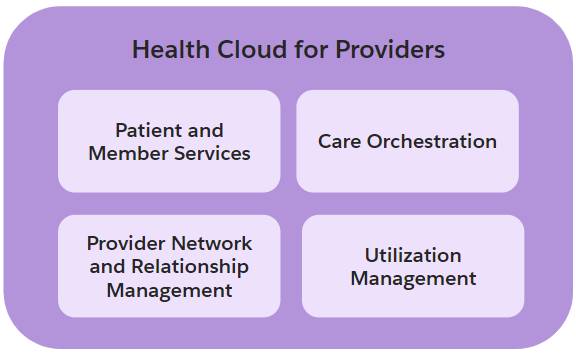Meet Health Cloud for Providers
Learning Objectives
After completing this unit, you’ll be able to:
- Explain how Health Cloud solves provider challenges.
- List the benefits of using Health Cloud for providers.
- Identify the capabilities of Health Cloud for providers.
Before You Start
Before you start this module, consider completing the following recommended content.
Healthcare Provider Challenges
Meet Luke Sandoval. He’s in his early 50s and coaches tennis at a university in Southern California.

Luke leads a hectic life and feels he’s neglected his health for a while. So he decides to get a full physical with his primary care physician at the Del Sol clinic.
Throughout his patient journey, Luke interacts with the staff members at Del Sol. Later in the module, you follow Luke and learn about who he meets at Del Sol and how his physical goes. First, here are more details about Del Sol Clinic and the challenges in patient management.
The main star of Del Sol Clinic is Elizabeth Lew, lead patient manager.

Elizabeth is doing a fantastic job at Del Sol, with several goals top of mind. She works hard to streamline care processes to serve patients better. A healthy workplace is mandatory, and she oversees programs and processes to minimize germ transmission. She manages at-risk patient populations and creates processes to help them follow their care plans. Wow, Elizabeth takes on so much.
However, her job comes with challenges.
- Demand for virtual care: Patients expect their clinics to adopt technology like virtual care. For example, they want to have video calls with their doctor and access their health records from an online portal. Both clinics and patients want to minimize in-person visits.
- Disjointed patient view: The complexities of sharing data across healthcare providers contribute to under-coordinated care. Medical care continues to shift to the home and into the community, and patients want more options for where to get care from. Providers struggle to share data with each other and with their patients. This results in substandard handoffs between the providers and disconnected experiences for the patients.
- Cost of care: Healthcare providers are seeking new ways to attract and retain patients as healthcare costs continue to rise. Many organizations are moving toward virtual care programs to reduce costs, deliver personalized care, and serve rural populations.
Del Sol implemented Health Cloud to help Elizabeth and other clinic staff conquer their challenges. Health Cloud allows them to do what they are best at: focusing on the patients and patient relationships. Here’s more.
Health Cloud Benefits
Health Cloud is built on top of the Salesforce platform and brings together clinical and nonclinical data into a single source of truth. Health Cloud helps organizations gain a 360-degree view of each patient to elevate the health experience, drive proactive engagement, and influence the best outcomes.
Here’s a look at how Health Cloud solves the challenges of healthcare providers like Del Sol.
- Deliver care from anywhere: Expand patient access in the home, online, or in-person with digital self-service tools and integrated health data on one secure platform.
- Strengthen provider relationships: Efficiently manage the physician network and improve collaboration with a unified provider record and guided workflows.
- Gain a holistic patient view: Connect clinical data, social determinants, and preferences on one platform to understand the patient journey.
Elizabeth can rest assured that with Health Cloud, her patients receive excellent care.
Health Cloud Capabilities for Providers
Health Cloud has many features that—in tandem with other Salesforce products—power solutions for common healthcare industry scenarios. For ease of reference, the features are categorized into feature groups, which are nonexclusive groupings of Health Cloud features into a set of industry-recognized categories.
Here’s a look at the feature groups relevant to providers.
- Patient and Member Services
- Care Orchestration
- Provider Network and Relationship Management
- Utilization Management

Patient and Member Services
These features focus on healthcare provider engagement with patients. Healthcare professionals can track and verify patient health and information, deliver personalized service to patients, and support their access to care.
Health Cloud provides a central dashboard that gives you a complete 360-degree view of each patient and their caregivers. You can see information about patients, such as the clinic they go to, the languages they speak, their conditions, and their medication prescriptions. And all these details are easily available without searching for this information or browsing other pages.
Meanwhile, patients stay engaged with on-demand access to their information from any channel, such as an online portal where they can view their records and self-schedule their appointments.
Learn how the features in this group map to tasks that different Health Cloud users do.
Patients
Healthcare Service Agents and Care Coordinators
To learn more about these features, see Engage with Your Patients and Members Using Health Cloud.
Care Orchestration
Care Orchestration consists of care management and care coordination, and it focuses on the actual delivery of care to patients. The feature orchestrates when, where and how patients receive care. Personalized interactions keep care teams and patients connected. Care teams can optimize their productivity and engagement with patients so they know when to intervene, improve patient outcomes, and reduce patient readmissions. This keeps patients engaged in their health.
Learn how the features in this group map to tasks that healthcare professionals such as doctors, care coordinators, care managers, and caretakers do.
Provider Network and Relationship Management
These features help you build and manage a provider network from recruitment, credentialing, contracting, appointment, onboarding, and beyond. The features reduce provider onboarding times and improve provider satisfaction. They also minimize operational costs across multiple departments and improve the accuracy of provider data.
Learn how the features in this group map to tasks that recruiting, credentialing, contracting, and onboarding specialists do.
Provider relationship features give users a full view of their provider network, including facilities, licenses, education, work history, references, and professional liability coverage.
To learn more about provider network management and relationship features, see Provider Network Management with Health Cloud and Health Cloud Provider Search and Cards.
Utilization Management
This group of features ensures patients receive the right care, at the right time, and in the right setting. Employ Utilization Management for utilization reviews, such as prior authorization and service requests, to better manage the cost of care. Assess the feasibility of treatment with evidence-based guidelines before a service is provided. With these Health Cloud features, respond constructively and transparently to any denial of care.
Learn how the features in this group map to tasks that providers do.
To learn more about these features, see Utilization Management in Health Cloud.
Next Steps
Now you have a clear idea what Health Cloud is and how it benefits providers. Next, get more insight into who works with Health Cloud and the tasks they must complete.